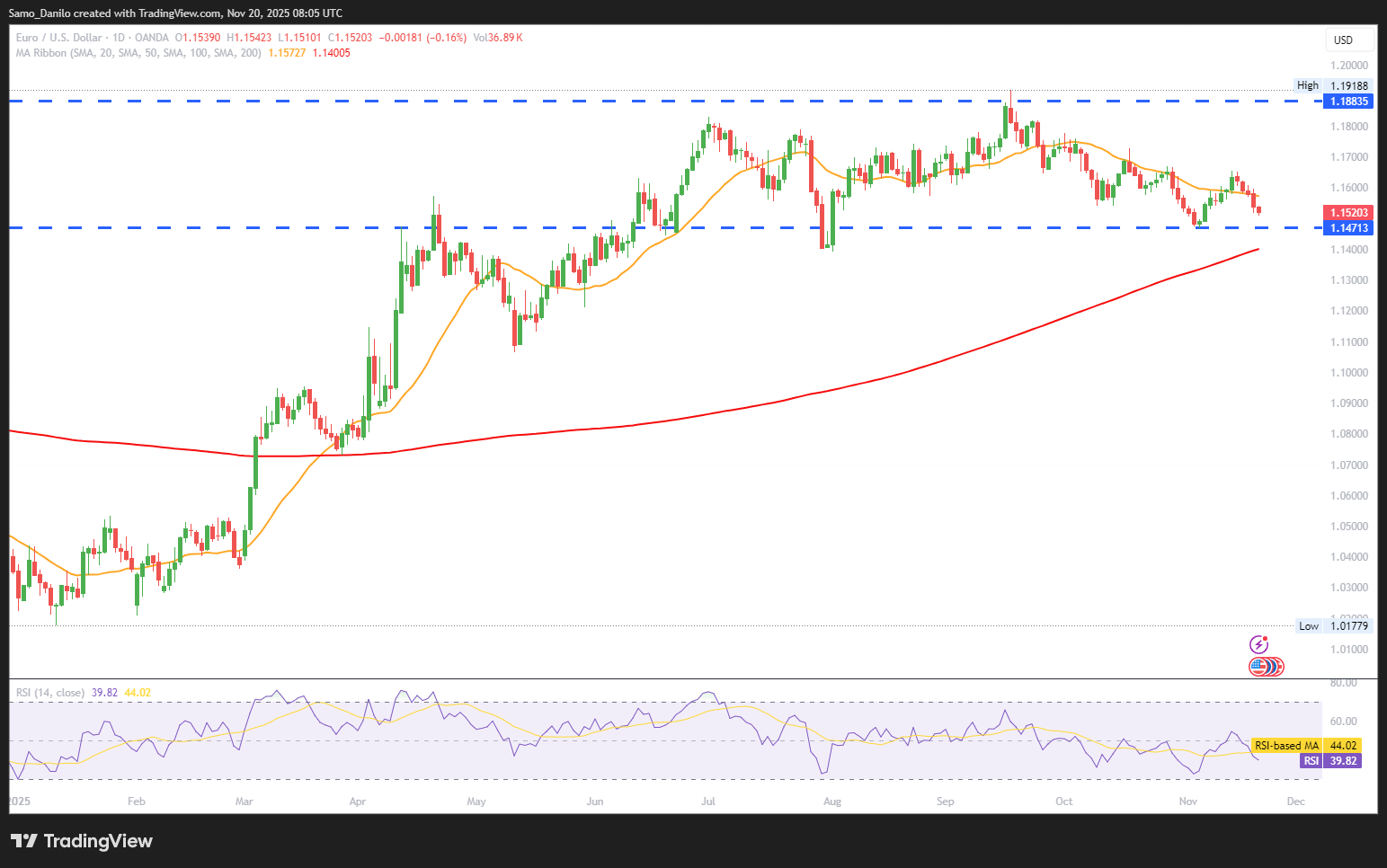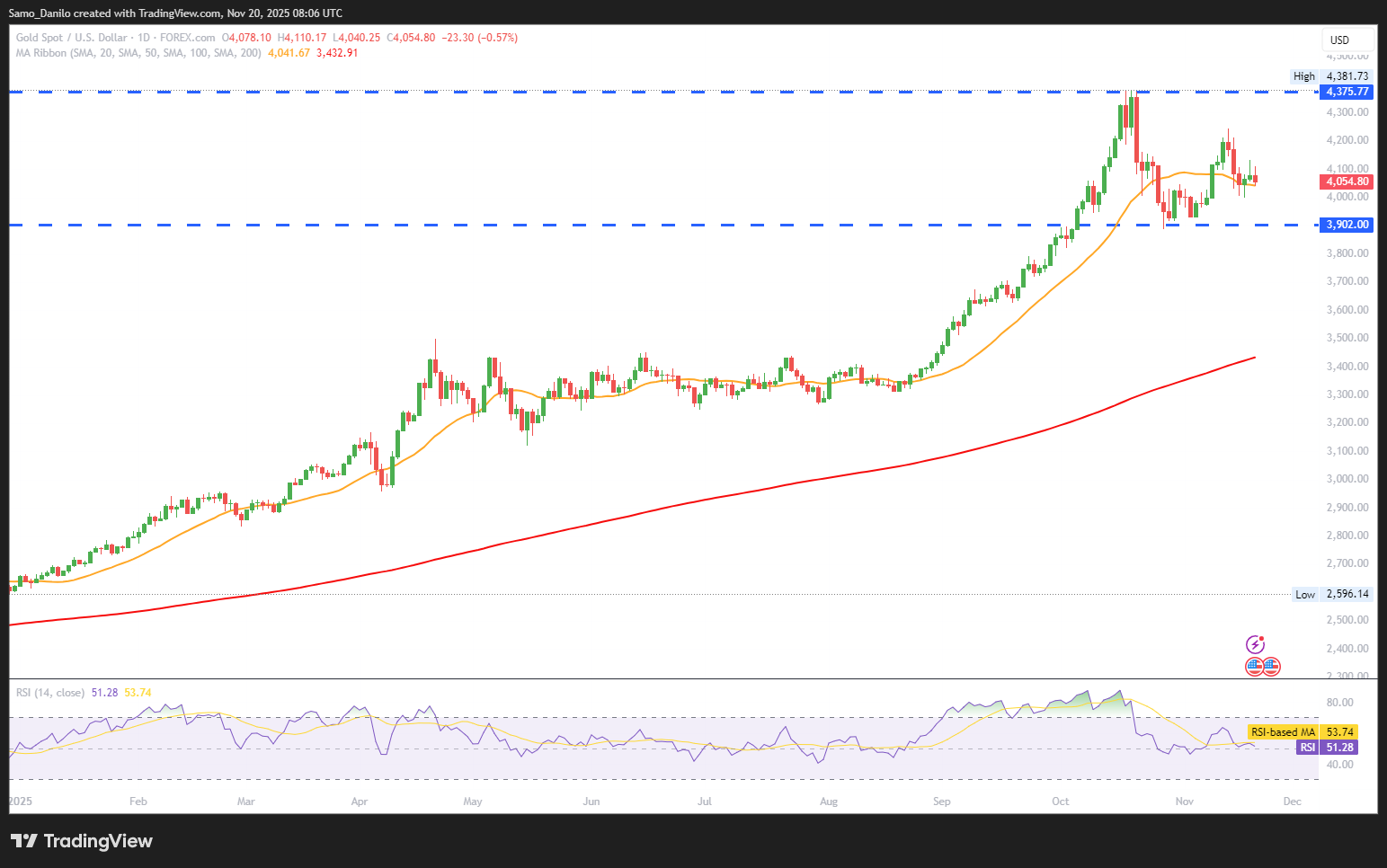EURUSD
- EUR/USD Price: The pair continues its downward momentum for a fifth consecutive session on Thursday. It now trades close to the 1.1500 psychological level, reflecting sustained USD strength and euro weakness.
- Eurozone Inflation: Headline inflation eased to 2.1%, down from 2.2% in September, while EU-wide inflation dipped to 2.5%. Although still near target, both figures show only marginal improvement from a year earlier, underscoring a “sticky but stable” price environment.
- ECB Rates: A majority of Reuters-polled economists see the ECB holding its current rate stance for at least two more years. Despite geopolitical uncertainty, consensus points to steady but modest economic growth with inflation remaining contained.
- Fed Minutes: Following Wednesday’s FOMC minutes, traders reduced bets on aggressive rate cuts. Many policymakers backed keeping rates steady in December, helping the USD recover and pressuring EUR/USD further.
- Consumer Confidence: The upcoming confidence data will offer fresh insight into household expectations amid weakening growth. Markets may react if the reading signals deeper pessimism or hints at stabilisation.
Closing statement: EUR/USD remains under firm downward pressure as diverging central bank expectations and subdued Eurozone inflation weigh on the euro. With sentiment tilted in favor of the USD, upcoming confidence data may set the tone for whether the pair breaks decisively below 1.1500.
GBPUSD
- GBP/USD Price: The pair trades slightly higher in early Europe on Thursday, breaking its recent downtrend. The recovery remains modest, with sentiment still fragile ahead of key macro releases.
- UK Data: Soft indicators, including CPI inflation, GDP, and Industrial Production, have reinforced the view that the Bank of England may cut rates next month. Markets increasingly see deteriorating economic momentum as justification for easing.
- Autumn Budget: With less than two weeks to the budget announcement, UK trade unions warn the OBR’s framework may limit policies aimed at improving living standards. This adds uncertainty to the fiscal outlook, indirectly weighing on the pound.
- BoE Meeting: Policymakers warned that lowering borrowing costs too early could jeopardize progress on inflation. This tension, between economic weakness and persistent inflation concerns, creates a mixed policy backdrop for GBP.
- US Labor Data: Economists anticipate 50,000 new jobs in September, up from just 22,000 in August, with unemployment expected to hold at 4.3%. A stronger NFP print would support USD resilience and limit GBP/USD upside.
Closing statement: GBP/USD has paused its decline but remains vulnerable as weak UK data fuels BoE rate-cut expectations while a potentially stronger US labor report supports the dollar. The pair’s ability to hold above 1.3050 will depend on incoming UK fiscal signals and Thursday’s US data.
XAUUSD
- XAU/USD Price: XAU/USD attracted sellers following a brief intraday rise, pulling back from the weekly peak reached on Tuesday. The move reflects profit-taking and renewed sensitivity to macro drivers.
- US Dollar: The Dollar Index climbed to a two-week high, making gold more expensive for overseas buyers. Analysts attribute the move to a sharp reversal in Fed easing expectations, tightening gold’s near-term backdrop.
- Peace Framework: Media coverage suggests a 28-point peace plan involving Ukrainian territorial concessions and major military reductions. While unconfirmed, such headlines reduce safe-haven demand for gold in the short run.
- US Kyiv Visit: A rare wartime trip by a US delegation to Kyiv seeks to restart stalled peace negotiations with Russia. The geopolitical uncertainty limits gold’s downside but hasn’t generated sustained bids.
- NFP data: The September Nonfarm Payrolls report, postponed due to prior government shutdown conditions, is due today. Signs of labor-market softening could revive Fed cut prospects and offer gold support.
Closing statement: Gold is losing momentum near its weekly highs as a stronger dollar and shifting geopolitical headlines weigh on sentiment. The next major directional catalyst will be the NFP release, which could either deepen the current pullback or trigger renewed upside if labor data disappoints.
CRUDE OIL
- Crude Oil Price: West Texas Intermediate trades near $59.40, slightly above Wednesday’s close at $59.28. The uptick reflects stabilizing sentiment after recent declines.
- Alaska Output: The EIA forecasts a 13% increase in North Slope production next year as two major fields enter high-volume phases. This marks the first notable upward shift in Alaska’s output trajectory in nearly a decade.
- Saudi Exports: JODI data shows Saudi Arabia’s crude exports and production hitting multi-month highs in September. The supply boost adds to global oversupply concerns that have kept prices under pressure.
- Global Oil Demand: JODI reported that worldwide demand jumped 1.4 million bpd MoM and 1.8 million bpd YoY in September. Stronger consumption offers a partial offset to bearish supply dynamics.
- Pakistan Strategy: Pakistan plans to build an artificial offshore island in the Arabian Sea as a fixed platform for deep exploration. The initiative, led by PPL, aims to counteract prolonged declines in domestic crude production.
Closing statement: WTI is firming modestly, but rising supply from Alaska and Saudi Arabia continues to overshadow demand improvements. The medium-term outlook remains tilted bearish unless global consumption strengthens further or supply growth moderates.
DAX
- DAX Price: The index continues to rebound for a second day, supported by improved global risk sentiment. Early Thursday trading shows steady momentum after yesterday’s partial recovery.
- Nvidia Earnings: Stronger-than-expected Nvidia results, with 62% YoY revenue growth, lifted the stock nearly 6% and eased fears of an AI-driven market bubble. This positive spillover is helping European equities stabilize.
- Producer Prices: Germany’s PPI fell 1.8% YoY in October, while inching up 0.1% MoM. Persistent producer-level deflation signals ongoing cost pressures and subdued industrial pricing power.
- Defense Stocks: Europe’s Aerospace & Defense Index dropped around 1.9% on Wednesday, reaching a two-month low. The decline coincides with geopolitical attention shifting to Ukraine following high-level Pentagon visits.
- Tax Revenues: Federal and state tax receipts increased 0.5% YoY in October. Still, the German economy remains fragile after two years of contraction, with the government expecting only 0.2% growth in 2025.
Closing statement: The DAX is stabilizing, buoyed by strong US tech earnings, though domestic economic weakness and sector-specific pressures remain headwinds. A sustained recovery will likely depend on improving industrial momentum and clearer global macro signals.




